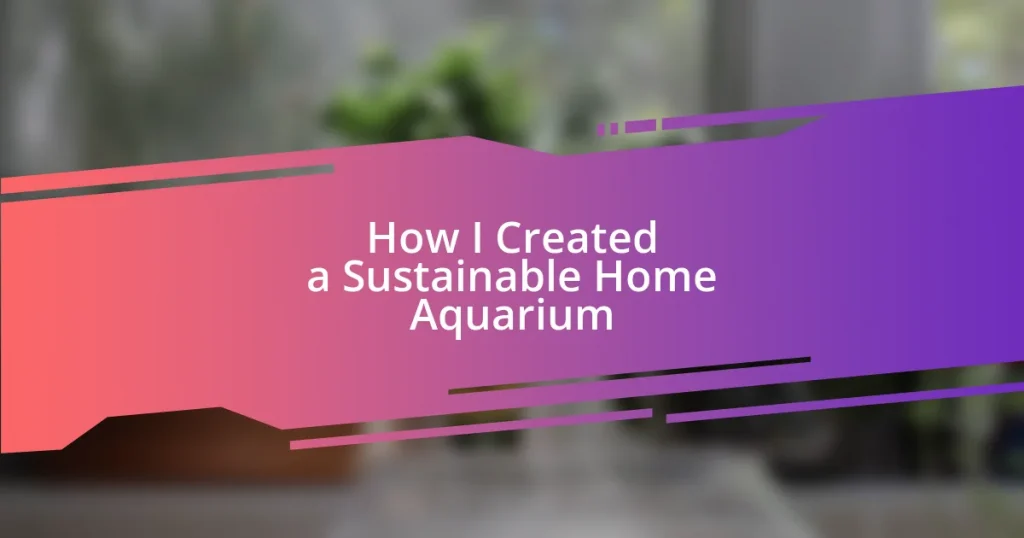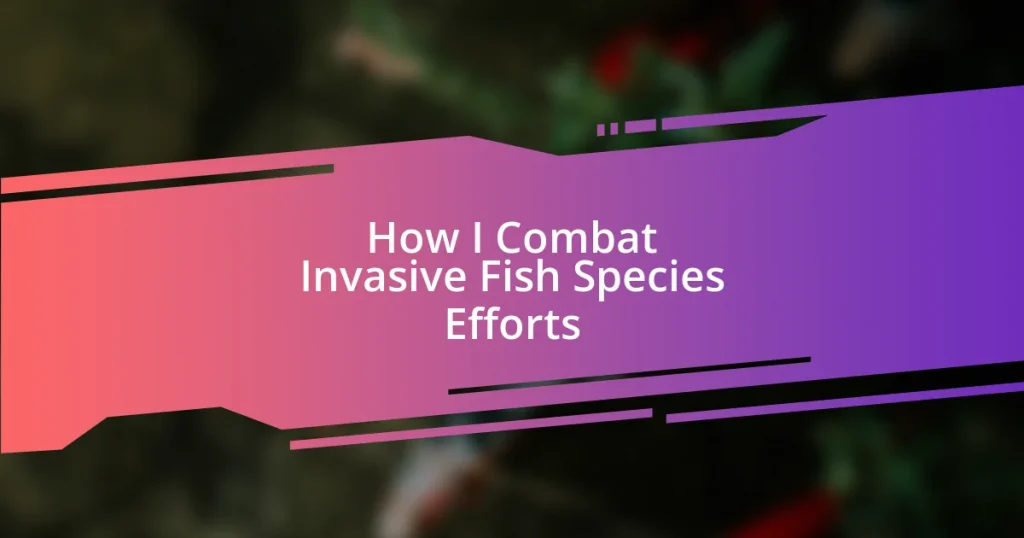Key takeaways:
- Choosing a mid-sized aquarium, such as a 55-gallon tank, offers a balance between manageable maintenance and space for fish to thrive.
- Selecting sustainable materials, like live plants and natural decor, enhances both the aquarium’s aesthetics and its ecological balance.
- Regular maintenance and monitoring of water quality are essential for creating a healthy, balanced ecosystem that supports the fish and aquatic plants.
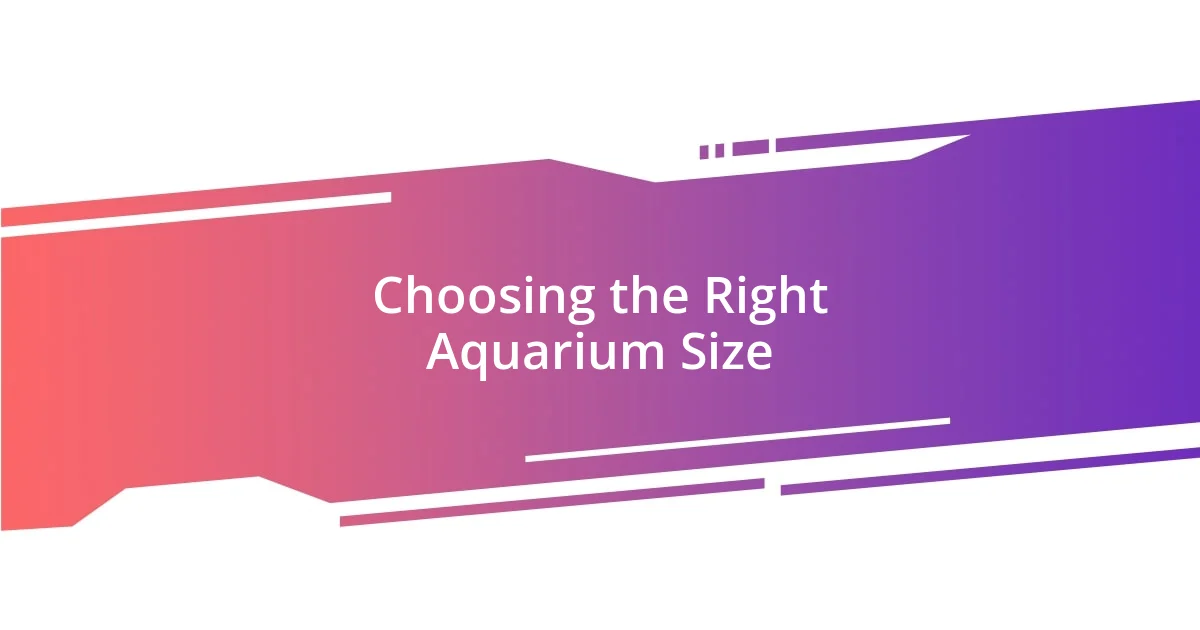
Choosing the Right Aquarium Size
When I was picking out my first aquarium, I quickly discovered that size matters more than I initially thought. A smaller tank might seem easier to manage, but it also requires more frequent monitoring, like water quality and temperature, since the smaller volume can fluctuate more dramatically. Have you ever found yourself wondering how much time you’re willing to dedicate to maintenance?
After some trial and error, I realized that a mid-sized aquarium offers a sweet spot for beginners. For me, it was a 55-gallon tank that struck the right balance – spacious enough for fish to swim freely but still manageable in terms of maintenance. I remember the sense of accomplishment I felt when I finally saw my little ecosystem thriving, filled with colorful fish darting around.
Moreover, consider the space you have available. I learned this the hard way when I spotted a beautiful 75-gallon tank but had to squeeze it into a corner of my living room. It not only cramped the fish but also limited my ability to enjoy the whole setup. Have you thought about how where you place your aquarium can affect both you and the fish? Trust me, planning your space wisely leads to much happier fish – and a happier owner!
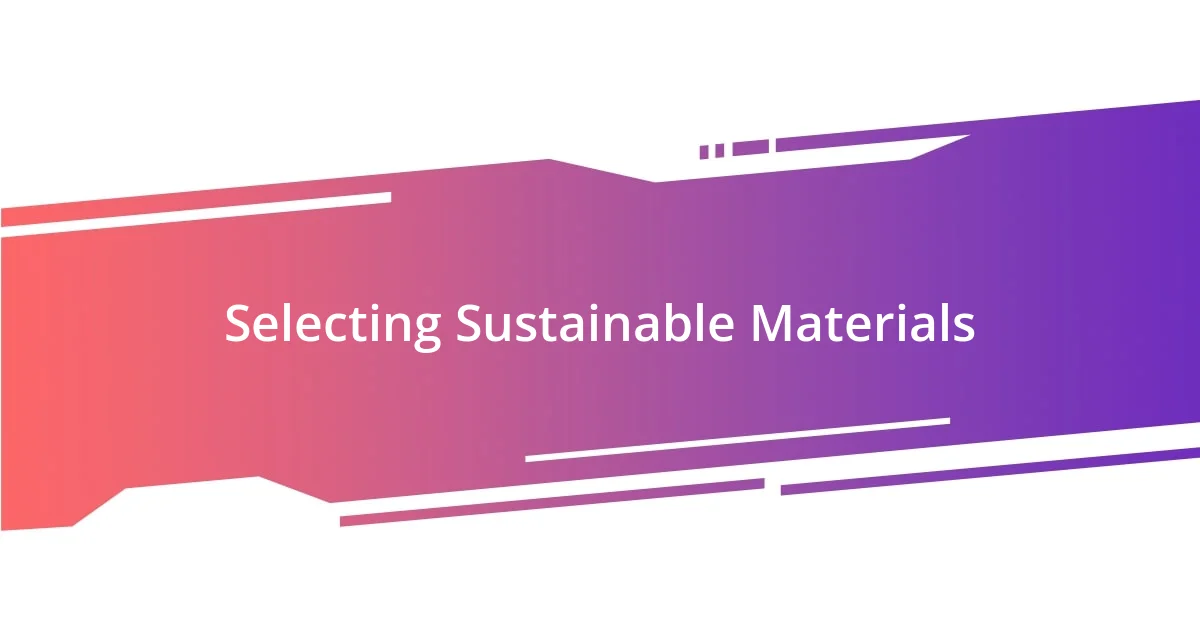
Selecting Sustainable Materials
Selecting sustainable materials for your aquarium is a crucial step that I found enhances both the aesthetic and ecological balance of the tank. As I was researching, I realized how vital it is to choose responsibly sourced decorations and substrates. For instance, I opted for live plants rather than plastic ones; they not only improve water quality but also provide a natural habitat for the fish. Have you ever thought about how your decorations impact the environment?
I also gravitated towards natural rocks and driftwood, which are often more sustainable than synthetic alternatives. I had a memorable experience when I discovered a local supplier that harvested wood from responsibly managed forests. Not only did these materials look stunning in my aquarium, but they also made me feel good knowing they were environmentally friendly. This connection to nature added an enriching layer to my setup, resulting in an aquarium that felt truly alive.
Keep in mind that the choice of aquarium equipment plays a critical role in sustainability as well. I invested in energy-efficient LED lighting, which not only reduced my electricity bill but also provided the perfect light spectrum for my plants to thrive. It’s these little choices that accumulate into a more sustainable environment.
| Material Type | Sustainability Factor |
|---|---|
| Live Plants | Improves water quality, enhances fish habitat |
| Natural Decor (Rocks & Driftwood) | Source from managed ecosystems, reduces plastic waste |
| Energy-efficient Equipment | Lowers energy consumption and costs |
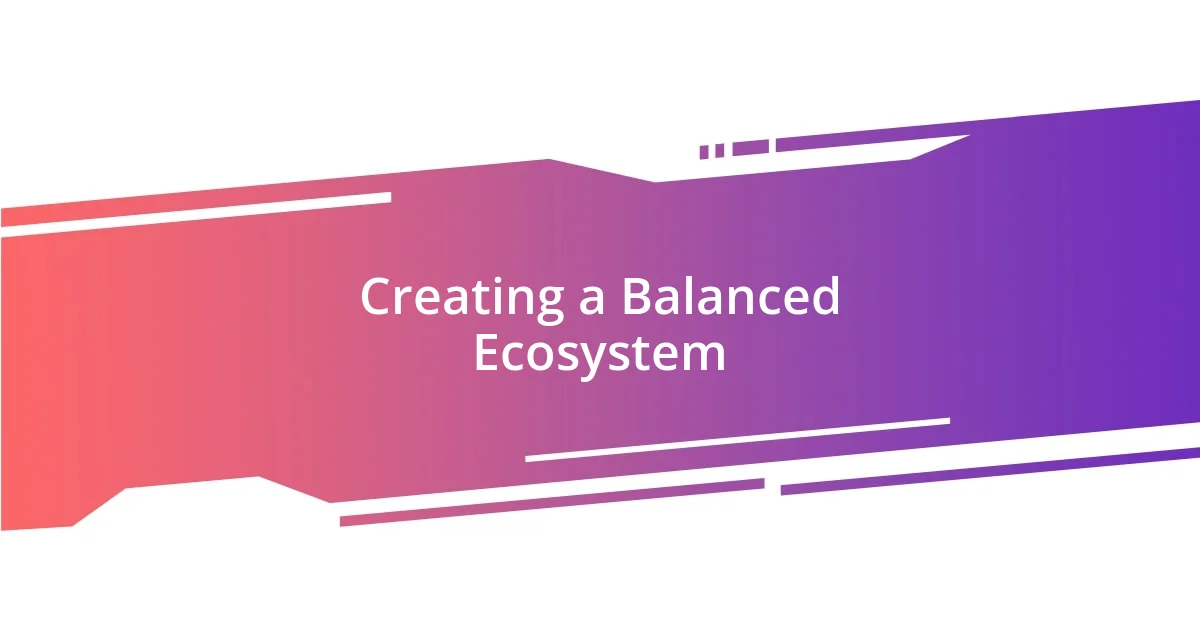
Creating a Balanced Ecosystem
Creating a balanced ecosystem in your home aquarium is pivotal for its success. I vividly remember the moment I realized that each component of my tank plays a role in this delicate balance. It’s not just about having fish; it’s about curating an environment where every organism can thrive together. I started by incorporating beneficial bacteria through a good cycling process, which helped decompose waste and prevent harmful ammonia spikes. Can you imagine the pride I felt when I saw my fish swimming comfortably, thanks to the balanced water chemistry?
To achieve this harmony, consider these essential factors:
- Fish Selection: Choose species that can coexist peacefully and thrive in the same water conditions.
- Plant Diversity: Incorporate a variety of live plants to contribute to oxygen production and natural filtration.
- Regular Maintenance: Schedule water changes and monitoring to keep the parameters stable; I’ve found that consistency truly pays off.
- Natural Filtration: Use a mix of biological, chemical, and mechanical filtration methods to maintain water clarity and quality.
- Monitoring Tools: Invest in quality test kits to keep an eye on pH, nitrate, and ammonia levels; it brought me peace of mind knowing I was on top of any potential issues.
I can’t stress enough how creating this ecosystem not only supports the life inside but also enhances my connection with nature. It’s like nurturing a little world where every detail counts, and each day reveals new interactions and behaviors among my aquatic friends. This symbiotic relationship reflects nature’s beauty right in my living room, making every moment spent by my aquarium feel special.
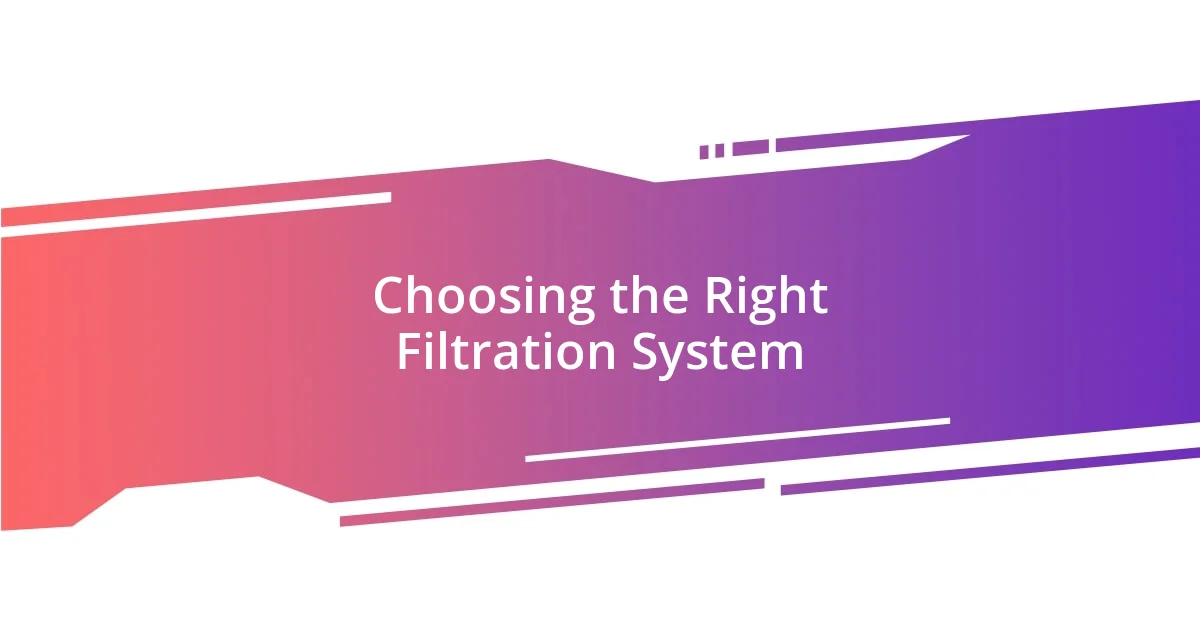
Choosing the Right Filtration System
Choosing the right filtration system for your aquarium was one of those decisions that really hit home for me. I spent countless hours researching different types, and it became clear that I needed a solution that not only kept the water clean but also aligned with my sustainable values. I settled on a combination of biological and mechanical filtration; the biological aspect allows beneficial bacteria to thrive, while the mechanical part captures debris. Have you ever noticed how the tiniest details can make such a big difference?
I remember the first time I installed my canister filter. The quiet hum of the pump felt like a reassuring presence in my home, and I loved the idea that it would actively purify the water. This system not only reduced the frequency of water changes—honestly, who has time for that?—but also promoted a thriving ecosystem for my fish. I felt a real sense of accomplishment knowing that I was creating a more stable environment with less energy consumption.
Ultimately, I learned that the best filtration system isn’t just about efficiency; it’s about creating harmony. I often reflect on how, in nature, the water is filtered by plants and microorganisms continuously. So, why should my aquarium be any different? Balancing man-made equipment with natural processes transformed my tank into a vibrant ecosystem, making it not just an aquarium, but a living piece of nature in my home.

Implementing Sustainable Plant Life
Once I decided to implement sustainable plant life in my aquarium, it felt like opening a door to a whole new world. I remember the excitement of choosing native aquatic plants that not only suited my tank conditions but also contributed to the ecosystem. Each plant plays a significant role; for instance, floaters like duckweed serve as a natural barrier against excess sunlight, which in return helps control algae growth. Have you ever wondered how something so simple can provide such a profound benefit?
Plant selection was just the tip of the iceberg. I quickly learned about the importance of substrate choice. Opting for nutrient-rich substrates allowed my plants to establish strong root systems, enhancing their growth and health. I vividly recall the moment I noticed new shoots emerging from my anubias plants; it felt like I was watching life unfold right before my eyes. The vibrant greens not only oxygenated the water but also created a haven for my fish to explore and hide. Each day, I found myself spending more time admiring the intricate dynamics between these living organisms.
Maintaining this lush underwater garden is a commitment, but it’s rewarding beyond words. Implementing a lighting schedule that mimics natural day and night cycles helped create an ideal environment for photosynthesis. I often catch myself marveling at how the plants sway with the water movement, creating a sense of calming tranquility in my home. Have you thought about how adding live plants can transform your aquarium into a peaceful retreat? Seeing my fish dart through the greenery makes me feel like I’m part of something profound—witnessing nature’s wonders, right in my living room.
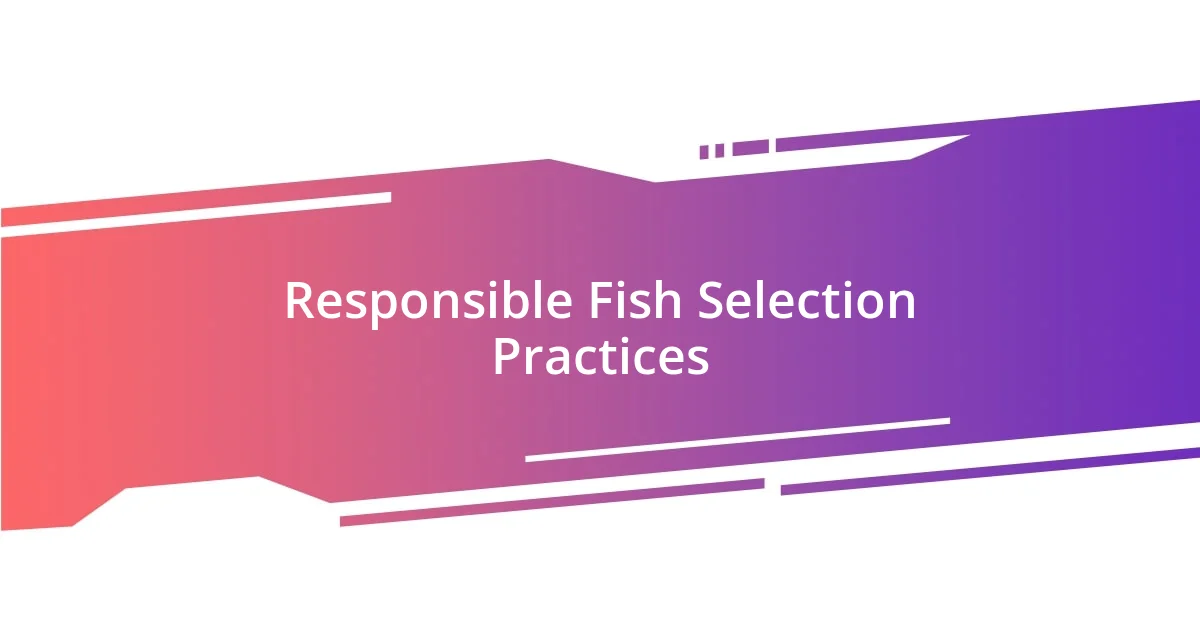
Responsible Fish Selection Practices
When it came to selecting fish for my aquarium, I realized it was essential to prioritize responsible sourcing. I distinctly remember walking through a local fish store, and I made sure to ask about the origin of the fish. It felt empowering to learn that many fish are bred in captivity, which helps reduce the strain on wild populations. Have you ever considered how our choices as consumers directly impact ecosystems? By opting for sustainably-sourced fish, I felt like I was playing a small part in preserving biodiversity.
I also found that taking the time to research compatibility among species was crucial. I had my heart set on adding a few colorful bettas and guppies, but I quickly discovered that their temperaments could clash. After some trial and error, I chose a peaceful community blend that thrived together. The first time I noticed my guppies schooling calmly alongside my betta was such a rewarding moment; it was like orchestrating my very own underwater ballet. It made me appreciate the delicate balance of nature and the importance of thoughtful selection.
One key takeaway for me was the significance of considering their natural habitats. By selecting species that matched my tank’s conditions, I provided an environment where they could truly flourish. Watching my fish engage with their surroundings was eye-opening. I realized that each fish not only had its own personality but also a specific role to play in my aquarium’s ecosystem. Isn’t it fascinating how every choice we make can foster a thriving community in our own little aquatic world?
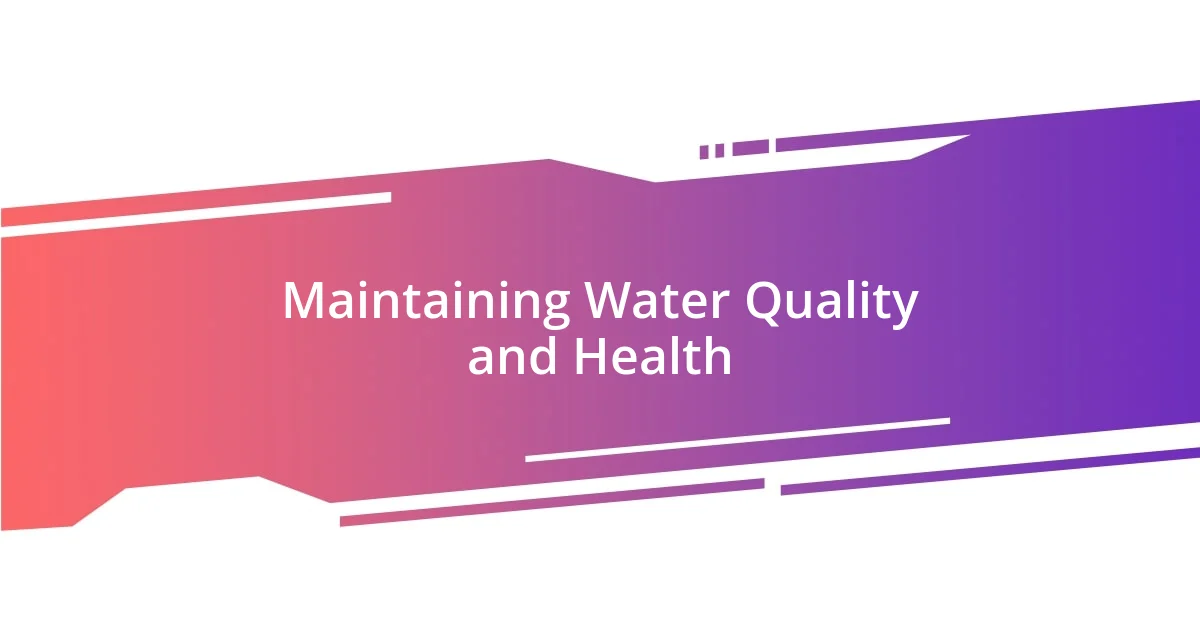
Maintaining Water Quality and Health
Maintaining water quality is a fundamental aspect that can make or break the health of my aquarium. I learned early on that regular water testing is critical. I remember the first time I checked the levels of ammonia and nitrite; I was shocked to see they were higher than I expected! It drove home the importance of using a reliable test kit and addressing fluctuations before they became an issue. Have you ever experienced that sinking feeling when your water parameters are out of whack?
To keep the water clean and clear, I implemented a weekly routine that includes partial water changes. I recall the satisfaction of watching the tank come back to life after a fresh infusion of clean water. By replacing about 20% of the water each week, I reduced harmful toxins and maintained a stable environment for my aquatic friends. It’s funny how such a simple task can fill me with joy while knowing my fish are thriving.
I also invested in quality filtration, which has been a game changer. When I upgraded to a canister filter, I was amazed at how effectively it circulated the water, keeping it crystal clear. I often think about how my fish seem to swim more freely and energetically now. Have you ever noticed how your pets react to a clean environment? It’s a true testament to the benefits of investing time and resources into maintaining pristine water quality.










